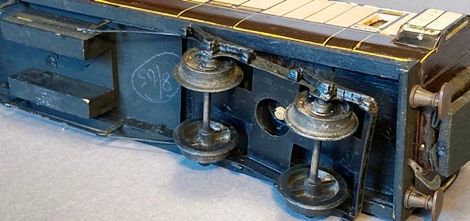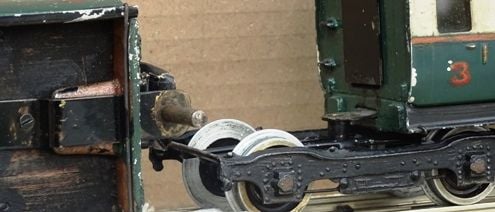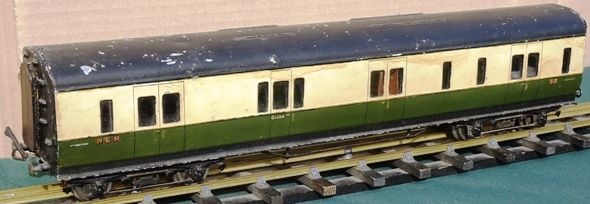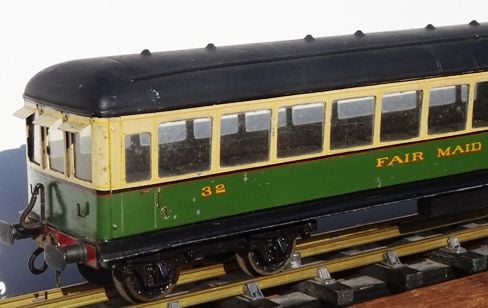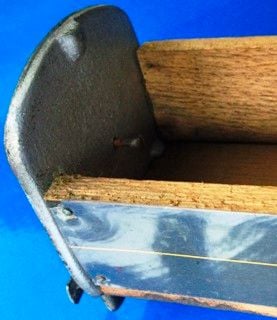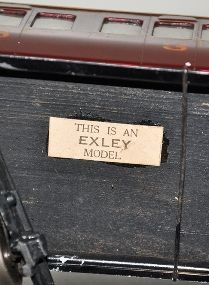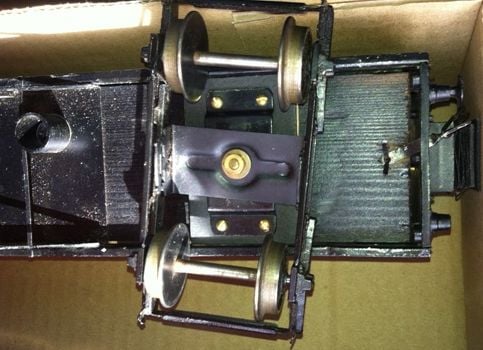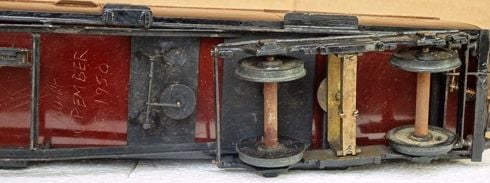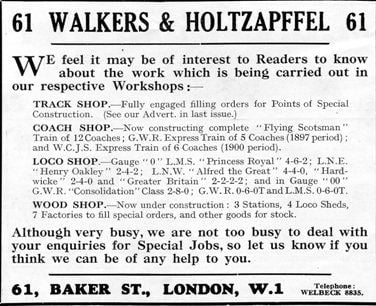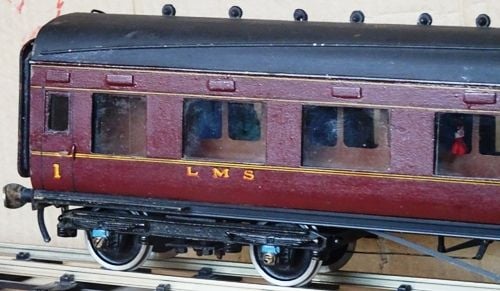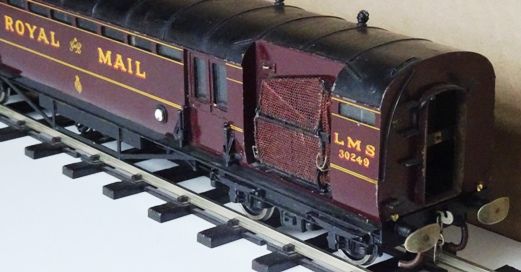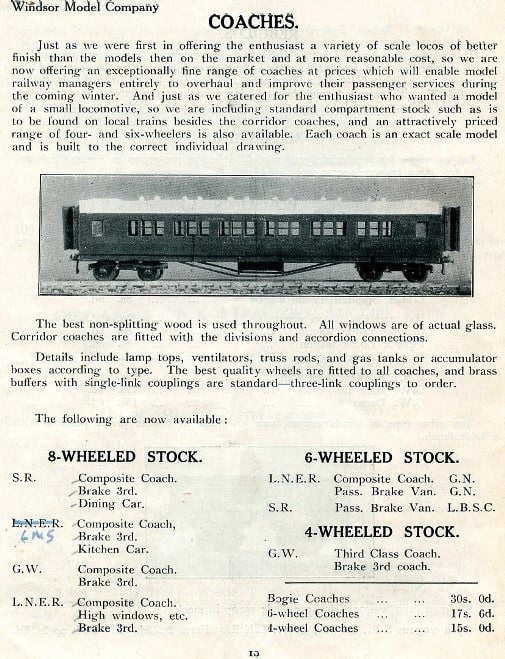
Coaches by other makers
Coaches made by some of Milbro's competitors and successors; material most recently added in March 2025
Copyright is retained by M.L.Harrison for all text and photos, except for those taken by other owners and enthusiasts.
M.L.Harrison 2020, 2025 © All rights reserved.
For purposes of comparison, and to supplement information available elsewhere from other writers, we comment briefly here on some features of coaches offered by Milbro's competitors and successors, and hope to enlarge material on this as information and time permit. At time of writing (late 2024) we have reasonable coverage of Exley, partly thanks to help from specific enthusiasts, and what I hope may be useful comments on a few other makers (including W & H, Douglass Models, and Bond's). There is also one example of a coach that is by an expert UK modeller who was not a commercial maker (Geoffrey Pember). This is included to show the use of bakelite, to complement LMC pictures of rolling stock made with this material. I need to add that for this section I am sometimes very dependent on information offered by other enthusiasts that I know, given the many limitations in my knowledge (and the need to rely on verification of the makers through people who have offered key photos).
Bond's
Illustrations OC10a-OC10c. Bond's catalogue descriptions and images from 1931-32 (2nd edition) and 1936-37 (2nd edition). The aim seems to have been to offer vehicles that had a high level of realism for the period.
Illustrations OC11a-OC11g. I am very grateful to the enthusiast who sent me these photographs of four Bond's coaches that were at one time in his possession. I understand their origin was confirmed at that time, although they did not have any trade mark or company label. I am informed they are of wood, with glass panes attached inside, and fitted with Bond's bogies. They have good interior detailing, and most likely represent specific coach types from the LMS period which fit the style of lining they have. These Bond's vehicles make interesting comparison with the W&H coaches shown below, as the aim is similar. The four coaches look to be in good order (although a glass pane has been broken at some point).
The pictures below show a Bond's LNER vehicle of similar good quality.
(The owner of this model explains that the curved coach ends are of carved timber, and about a quarter inch thick. The roof fits within the two ends, and - as can be seen above - gently curves down to meet them.)
(I am informed that these bogies, with their 'sheet brass stretchers', come from a later period than those on the LMS coaches shown above.)
(This label uses the Bond's pre-war address, but it is conceivable old ones were still being used up in later periods, so it remains hard to be sure about the vehicle's production date.)
(The door handles are of brass, and appear to be good representations of the full-sized ones; the owner of this coach suggests they might perhaps be castings.)
Illustrations OC11j-OC11p. This is a well-built and nicely-proportioned Bond's LNER teak coach that seems most likely to have been made in the late pre-war or the early post-war years (although it is hard to be certain). I am grateful to its owner for letting me have these photographs, and for also providing an informative analysis of its construction details. The label suggests pre-war origins (see our note on plates in the section on Bond's locos and motors), but old versions might well still have been in use after the war. The body and roof of this vehicle are of wood, and its windows are of glass. It has brass buffers, and brass handrails behind some windows, and its Gresley bogies are of a very recognisable Bond's type (see comment above for Illustration OC11l). The buffer beams are screwed to the underframe, and the underframe is screwed to the body. The Bond's label underneath the body confirms that this firm supplied the coach, but the maker could have been either a sub-contractor or the firm itself. It seems possible that use was made of coach parts originally made by Milbro, or supplied to Bond's (or its sub-contractors) by CCW. The owner notes that each window appears to be separate, and that they have been inserted into slots in the body sides, a technique used by Mills before the war and by CCW later. There is an interior corridor partition and separate compartments. The inside of the roof (the ceiling) is curved rather than having the flat profile familiar in Mills coaches, so if a supplier was used for parts then CCW seems a little more likely than Milbro. Today, however, it is difficult to know without documentation what was done when this coach was made, and I also have no information on what happened to any stocks of Milbro coach materials after the war.
Douglass Models
We comment generally about Douglass Models in our website section covering their locos and those made by Vulcan of Kendal. The photographs (from enthusiasts) below complement that material as far as coaches are concerned. First, however, we reproduce some magazine pictures of items made for running on his own layout by the firm's proprietor, R.D.W. Brittain. In the history of 0 Gauge, the development and operation of small firms sometimes related closely to the interests and activities of individual enthusiasts and their engineering and design skills. Perhaps the layout models shown here formed the basis of some of the range of items that were subsequently sold through this firm. Illustrations OC16(Bi)-OC16(Biii). These images are from The Model Railway News issues of January 1947 and August 1948. They appeared in articles by R.D.W. Brittain, discussing his own model railway. Amongst his 1947 comments is the statement that all the coaches were "home-made from plywood and suitable canary wood". See "Six L.N.E.R. coaches", 23, 265, pages 2-3; "An L.N.E.R. Sentinel", 24, 284, pages 152-153, 159.
We now show some examples of coaches from the company's range. I am grateful to the photographers and owners who provided the images below, which indicate the good quality achieved by this post-war producer. The vehicles have a neat and convincing appearance, and the finish and style are rather striking.
Illustrations OC16a-OC16c. Three photos showing aspects of a model representing an LNER all third bogie vehicle. Note the shaped coach ends and Milbro-style corridor connections. Many thanks to the enthusiast who let me have these pictures and the others below of LNER and LNWR models by Douglass.
Illustrations OC16d-OC16f. Images of two LNER 6-wheelers, again including detail of the construction underneath (for the full brake).
Illustrations OC16h-OC16j. These pictures show the style and construction for a Douglass Models LNER articulated pair. The method of joining the coaches is seen in the second illustration.
Illustrations OC17a-OC17c. Three images of a Douglass LNWR coach, showing robust construction allied with some convincing detailing and handsome 'artwork'. Again, thanks to the photographer for letting me use these pictures here.
Illustrations 0C17d-0C17f. Three pictures from a different collection showing another Douglass LNWR coach, which appears to be in almost 'unused' condition. Many thanks to the owner for these images.
Illustrations OC18a and OC18b. Another intriguing and very distinctive model. Exley Exley coaches are very well known amongst model railway operators and enthusiasts, and the firm produced them over a long period, from the pre-war vintage era through into the second half of the twentieth century. The standard 0 gauge ranges were extensive, and the vehicles generally have a convincing and attractive appearance. Coaches of this type have metal bodies (made in a wrap-around form incorporating roof, sides and solebars), wooden bases (albeit with some attached metalwork), and cast ends, so that there is a very clear contrast with the items from Milbro's wooden standard coaches range or the LMC ranges. The visible difference from Milbro is accentuated when the Mills coaches have full early-style panelled sides rather than flush ones. For the windows, Exley used long strips of glass running through the length of the vehicles, and held by spring clips (whereas Mills coaches have individual panes fitted into slots in the wood, and coaches from some other makers have glue to fix the glass). The best published source on Exley coaches I have seen is Ramsay's Guide, and I will draw on the seventh edition now for key points about these vehicles. Readers can find a fuller description there (including coverage of Exley 00 gauge), together with useful illustrations: see "Ramsay's Catalogue of British Model Trains", Compiler and editor Hammond, P., 7th Edition, British Railway Modelling, Warners Group Publications, Lincolnshire, 2011. Hammond notes that the Exley "coaches made before 1940 tend to be more accurate to the prototype", whereas in the post-war years ("after the introduction of the K5 series, which were largely based upon the LMS Stanier profile"), it became "a matter of changing livery, rainstrips and window positions" (page 189). Importantly, the tooling for the coach bodies was upgraded around 1950 "to the style most commonly found today" (page 187). There were also changes in the same period to the ends on Exley coaches. In the pre-war years these had been alloy castings showing planking detail, and were "bowed if it was so on the prototype", whereas the new castings were to a more modern pattern "based on the LMS Stanier coach end" (page 188). Bogie designs also differed from the earlier period. It seems that detailing underneath coaches was initially very simple for standard coaches (with wooden box shapes before the war, similar to those on Milbro vehicles), but that in the decades after the war pressed metal battery boxes were deployed, and underframes became more detailed. Hammond also notes that the wooden floors sat higher inside the coach bodies during the pre-war and early post-war period (page 188). I have found that this may affect the space available for seating; possibly meaning there is insufficient height for putting in full seats and sitting passengers. As well as the coaches from the standard ranges that are familiar to today's enthusiasts, Exley also produced some cheaper models, and we show one of these below. Relatively little seems to be known about this 'economy' range. Exley coaches may quite often be found set up for two-rail running, and the post-war ones have a relatively fine-scale 'look' that makes them useful for a variety of layouts. I understand that in 0 gauge the post-war versions are preferred by some collectors today, and these include the K5 and K6 types (the latter perhaps being seen as the best). At the same time, however, we can note that some especially rare and distinctive pre-war vehicles may remain sought after. Further developments in the post-war years after the K6 range are noted by Hammond, including the use of an Exley 'Moddex' trade mark, and plastic coach ends (page 188). We show some examples of Moddex vehicles in LNER livery below. It seems that plastic might also be utilised in the later years for some components underneath the coaches. I have been informed that after the production of standard types ceased, further items were marketed from Exley at Baslow; reference is sometimes made in that context to coaches described as being by 'Clegg for Exley'. I gather that body pressings could be sourced by Clegg in these years from his own production or from Westdale. It is important to note more generally that specific distinctive items were also available from time to time from Exley over a long period, some being made to meet particular requests. We show now a few examples of Exley coaches and their details, to give an idea for those unfamiliar with them of what they are like. Many enthusiasts know a great deal more than I do about Exley rolling stock, and my accompanying comments rely partly on other people. First, some pictures are shown of five LNER Tourist Stock coaches, made before the second world war or fairly soon after it. This is an interesting set, which seems to have been supplied in two stages, since there are differing company labels underneath the two articulated pairs, and a difference in brightness of the paintwork. They are all bulky vehicles, have interior detailing, and include some coach ends that I am informed are similar to those on pre-war Gresley teak models made by the firm. As the articulated pairs are unusual, I have included some pictures showing how the coaches are joined together.
Pre-war/early post-war examples of Exley coaches
(This is an early articulated pair of LNER tourist stock coaches. The coach roofs curve downwards at the outer ends, suggesting the bodies possibly might have been drawn by Exley from their standard Gresley items, made more usually in teak colouring.)
(This section of an Edwards Bros drawing of an 'Articulated Bogie Third for Tourist Trains (1933)' shows that the coach ends at the 'join' in an LNER two-car set were indeed flat and vertical as represented above.)
(Details at one end of the pair.)
(I have tipped the left-hand coach up on its side here, to show the large 'post' that makes the link to the bogie !)
(Early trade mark carried on three items in this five-car set.)
(A single coach that would have been part of the same special order as the above pair. A very plain wooden box shape is visible below the body, very similar to what can be seen under a standard Milbro coach. (NB. I have an Edwards Bros drawing of an '8 Wheel Brake Third for Tourist Trains (1933)', so it seems likely that having a single brake coach to work alongside the articulated pairs would have been one of the normal possibilities.)
(A second pair, with brighter paint and including a Buffet Car. Buffet Cars were part of what was on offer from the LNER amongst its tourist stock in the 1930s.)
(The light has reflected badly in this picture, giving the impression of a horizontal line along the green paintwork! I had a bit of trouble taking good photos of these vehicles, but will have to wait until I get a bigger slot of time to do some better ones.)
(This probably makes the upper paint on the side look whiter than it actually is, but gives a glimpse of some of the interior detail.)
(Later transfer, carried on the Buffet Car and its accompanying coach.)
(The connecting up of the articulated coaches was solid and very simple, but seems to work.)
(Pre-war Exley LNER bogie, plain wooden floor, and fairly basic construction style of the coach ends. See below for an example of the similar bogie from this period that was not to the LNER design.) Illustrations OC24a-OC24l. Exley 5-car LNER tourist stock set, composed of model vehicles that seem to have been commissioned in two slightly different periods, but all dating from the pre-war or early post-war years of production. I think it probable that these coaches were from two special orders for the same enthusiast, but I do not know enough about Exley to speculate on how many other similar green-and-cream pre-war sets or individual coaches like these may exist in collections or on layouts. A swift hunt for internet images of the full-sized tourist stock of the pre-war years did not find me pictures showing LNER green-and-cream vehicles with Gresley-style 'turned down' coach roof ends like those on these models. It seems, however, that there are two available diagrams showing full-sized vehicles with ends like these; a twin set and an open third brake. Apparently those LNER coaches were probably completed for the NB section after the outbreak of the war, in or after 1939. Our Exley examples may well have been made after that date, for someone who wanted this pattern of tourist stock coach body. If not, our coaches (or some of them) might have been made earlier on, before the full-sized versions were in service. A knowledgeable collector has suggested to me that if these Exleys were not made correct-to-prototype, then perhaps the firm simply offered to make use of their standard LNER Gresley coach bodies and the purchaser was happy with that. I do not know, however, how to be more precise about production dates here, but it seems that Exley was applying detailing on the glass windows (ventilation, etc.) by 1939 (see Beal, E., 'Scale Railway Modelling To-day', Black, London, 1939, opposite page 200). Regarding special orders in general, I have been informed that there is a very rare special order set designed to represent the West Riding coaches that ran behind LNER streamliners before the war, but some readers will know a great deal more than I do about Exley commissions. Some LMS 'streamliner' coaches that appeared to be by Exley were advertised on Ebay in 2021.
Illustrations OC24li and OC24lii. Some time after I put the pictures of the tourist stock set on this site, an enthusiast helpfully sent me photos of a similar vehicle he had recently acquired. This is a separate buffet car, indicating that a set could have been built up without articulated vehicles if desired, or a separate buffet could have been added to an ordinary articulated pair.
Illustrations OC24liii-OC24lv. The livery of this early vehicle is puzzling, but I think it would sit quite nicely with the tourist set above or the Sentinel shown below. It is most likely a part-repaint from many decades ago, either done by its owner or (perhaps more likely) as a professional commission from one of the smaller firms. If so, perhaps the intention might have been to create an LNER tourist vehicle, a holiday coach, or even something with Highland Railway connections. It was one of several coaches with matching livery that turned up on Ebay in 2021. They (and others) had belonged to a layout that had also had some Highland wagons. The second photo above shows one of the coach end types that were in use in this period for standard coaches, and the third contains one of the original bogies and the fitting that held it. The fitting simply bolted into the wooden floor. The fittings, bogies and wheels had been altered and deteriorated very badly, so I replaced them with Bassett-Lowke ones. The vehicle appears to have faint markings for strips or bands running across the roof.
Illustrations OC24o-OC24r. This Exley Sentinel railcar also seems to be from an early period of production. I have no information on how many vehicles like this may have been produced . Other pictures of it can be seen in our section on Exley locomotives. The exterior is in good order, but some modest renovation is needed inside and underneath. The motor unit and the other bogie may not be original. Note that both this railcar and the tourist stock coaches shown above have very simple windows, without any detailing to indicate ventilation, opening lights, etc. This may be contrasted with the later coaches shown below. Another Exley version of this railcar was supplied to the Craigard Railway and shown in an article by Edward Beal in The Model Railway News in October 1935. It had more detailing than the one shown in our photos above. We discuss it further in our website section on Exley locomotives. (See 'News from the Craigard Railway', 11, 130, pages 266-268). Many thanks to Bill Truin for drawing my attention to the Beal article. The model we show here was included in 1970 in the late P.G. Gomm's very informative book, 'Older Locomotives (1900-42)'. (Troy Model Club Series, Nelson, London. See opposite page 37.)
Exley 'economy' coaches I am grateful to Martin Ford for outlining the characteristics of this range of more cheaply made models, and helping me access the pictures below. Martin's analysis refers to metal coach-end castings, a metal wrapper forming the sides and roof, and three elements used for representation of the windows. These elements are a thin sheet of transparent plastic/celluloid, a backing strip of black paper, and a wooden strip to which the sheet and paper are nailed. The 'window wood' is then held in place by a nail through each of the coach-end castings, but is not attached to the coach floor. A corridor handrail is represented by a brown/yellow painted line on the inside of the celluloid strip. Martin also notes that the 'handrail' line runs the length of the coach, continuing across its door windows. The bogies appear to be unique simple ones, presumably made specifically for this economy range. The body wrappers also appear to have been produced so that these short vehicles could be offered by the firm. It seems that there may be some variation amongst coaches in this range, both in lettering/numbering (by transfers or by hand), and in the body shells (probably mostly aluminium but also occasionally tinplate). It seems that although various vehicle types have been seen, the available 'sample' may be too small to make clear generalisations about the scope of the range (unless documentation can be found).
Illustrations OC24t and OC24u. An Exley coach from the firm's 'economy range', together with a picture showing the interior construction below window level.
Later post-war examples of Exley coaches
Illustrations OC25a, OC25b and OC25c. These pictures show features very familiar to Exley operators, including a company label, interior detail (with seats), and metalwork underneath the coach attached to a wooden base. The firm's labels quite often seem to be missing.
Illustrations OC25d-OC25f. I am grateful to the enthusiast who sent me these pictures of a coach that has another version of the firm's label. I do not know when this was being applied. Since putting these photos up, I have been advised by Martin Ford that this appears to be another example of a coach from the 'economy range' described earlier. He adds that - if so- then it is pre-war, and the original bogies have been replaced by later ones.
Illustrations OC25g and OC25h. Examples of a cast coach end and Exley's own standard sprung bogie. I am informed this is the version from the post-war period. It is mounted on an aluminium fitting attached to the wooden coach underside. I understand the sides of the unit are castings, while the bolster is of tinplate.
Illustration OC25i. A Bassett-Lowke bogie, as found on some Exley coaches. This is mounted on a shaped steel bearing plate screwed onto the wooden base of the coach. Bassett-Lowke marketed Exley coaches along with the products of some other companies (including Milbro).
Illustrations OC26a and OC26b. An Exley late period high quality LNWR coach, probably part of a smallish batch (or conceivably even perhaps a single special order item). This is not one of the Clegg vehicles noted above (and illustrated below). I think that this is an exceptionally attractive model, with its convincing paintwork and excellent 'toplights', and it is in superb condition.
Illustrations OC27a-OC27c. Views of a 'Clegg for Exley' BR coach.
Illustrations OC28a-OC28c. An Engineer's Inspection Saloon made by Exley. Hammond (cited above) gives the production period for this item (tentatively) as 1957-1962. I understand that the particular model pictured here would have been classed as a super-detailed version, and serves as an example of what the company might provide at that level in its later years.
(The lower part of the coach side has come out poorly in my photo here, but the aim is mainly to show the detail below it.)
(The late type of bogie.)
Illustrations OC28e-OC28j. These pictures show some features of LNER suburban coaches from the Moddex period. I've been unsuccessful with the quality of the photos, but I think the main details can be seen. The coaches were parts of a five-car set supplied by the firm using modern materials and for two-rail running.
Jubb Martin Ford has provided some useful information and catalogue material on Jubb coaches. The firm is described and discussed in more detail in our section on Wagons by Other Makers. This company (which used the title JLS) disappeared early in the 1920s, and lies a little outside our main focus. It seems to have been more significant in Gauge One than in 0 Gauge. Jubb's short-lived relationship with Henry Greenly was very important, however, as the firm marketed coaches based on a Greenly construction methodology that has something in common with the approach adopted by Milbro. Mills certainly worked with Greenly, and perhaps the Greenly approach was taken up by Mills when his links with Jubb were ended. Many thanks to Martin for indicating this history, and for providing the catalogue extracts below.
Illustrations OC30a-OC30d. Jubb's coaches seem to have been built using a construction methodology created by Henry Greenly. This involved interlinked machined parts, with glass mullions and panels interlocked by suitable grooves and tenons. It could generate sunken panels, and the glass did not need gluing to the wood. This methodology may have been the starting point or original source for what Milbro did to make its wooden coaches and kits. The method was probably at its best in the larger scales. It seems that a Gauge One coach might neeed 300 parts. Many thanks to Martin Ford for explaining this history.
Illustrations OC30e and OC30f. I believe these two rare Gauge 0 bogies may well be by Jubb. They have something in common with Milbro ones, but are nonetheless quite distinctive, and seem apparently a little similar to those shown in one of the catalogue images above (see 'view of parts'). They are very robust and heavy, and one has stamped numbers and a letter. My guess is that these may well have provided a basis for the design of the Milbro ones, and could even have been produced by Mills themselves.
Leeds ..................... To come later !
Illustration OC32. Innovative production by LMC; the bakelite coach series.
Meersbrook Model Co. (later renamed as Scale Product Co.) This company was based in Sheffield, with additional premises in London, and offered a wide range of models and parts. We have said a little more about it in our section on Wagons by Other Makers. The catalogue pictures, comments from the catalogue, and an advertisement (shown below) are the only information I have so far seen on the firm's coaches.
Illustration OC40a. A catalogue page from Meersbrook Model Co.
Illustration OC40b. An advertisement from this firm, showing coaches. Bill Truin points out that these appear to have been made using LMC Lithos, but not Leeds bodies. This is from the Model Railway News of March 1928; 4, 39, page v.
Pember Geoffrey Pember was an enthusiast, author and authority on railways, rather than a commercial maker or retailer of model railway items. His 7mm railway models, however, seem to have been much admired for their quality and unrivalled accuracy. The superb model coach shown below provides an interesting example of the use of bakelite on a specific building project by a highly expert individual modeller. It is well known that Leeds Model Company built some of its rolling stock (including coaches) using bakelite. The coach below is the only example I have to hand where this material has been used by another builder to help make an 0 gauge coach, and thus the only item available to record alongside what was undertaken (on a commercial basis) by Leeds. Readers unfamiliar with this modeller may be interested to note that Pember was an acknowledged expert on the Great Eastern Railway, and his work on GER 0-4-4 tank locomotives is cited in our section on Beeson. His great skills and innovative approaches as a model-maker can be seen in a Gauge O Guild slide collection item noted below, but also in contributions he made in print to advise others (see in particular Pember, G., 'Notes on 7mm Scale Modelling' Part 2, in Gauge O Guild Gazette, IV, 6, April 1970, pages 6-7). The GOG slide set dealing with and illustrating Pember's modelling is very informative (Gauge O Guild, 'Models by Geoff Pember', 1981). Amongst his railway models were complete scenes/set pieces that included highly accurate buildings, signals, etc. His locos and rolling stock were made with great care, and matched the full-sized locomotives as fully as possible. He created rivets by using small pins (and preferred entomological pins of a specific size). His fine work on signals has been acknowledged by inclusions in publications (see for instance Williams, G.R., 'The World of Model Trains', Andre Deutsch, London, 1970, page 204; Hornsey, P. [ed.], 'An introduction to model railways', New English Library, London, 1977, pages 78-79). The latter book also shows a GE crossing keeper's house at page 73. After photos of the LNER coach below, we illustrate the meticulous care Geoff Pember took over representing features in the GER railway environment; in this case two small seats. There is a good-sized photograph of one of Pember's GER loco models in a book he contributed to. This is Allen, T. (ed.), 'The Encyclopedia of Model Railways' Octopus Books, 1979; see the paperback version, Hamlyn, London, 1987, page 13. The accompanying caption notes it took him 700 hours to scratch-build. The model shown below dates from 1950, and was included in the slides taken for the Gauge O Guild.
Illustrations OC45a-OC45e. Coach made by Geoff Pember using bakelite. Pember was regarded by some enthusiasts in the postwar decades as the most impressive and accurate of all the UK's 7mm modellers, but does not fall within the 'commercial category' that is our central focus. His modelling work was outlined in an excellent Gauge O Guild slide set that was transferred to disk ('Models by Geoff Pember', 15, 1981), introduced by Jack Ray and with full commentary by Pember himself. Pember described and showed this coach, a bogie brake, when Jack Ray made the slide collection mentioned above. The aim for the coach seems to have been to try laminated bakelite as a possible way of representing varnished and weathered teak. The roof is of wood. I bought this model on ebay because I wanted an example of this type of coach from the vintage or 'late vintage' period. I then discovered its historical significance, and feel privileged to have it.
Illustrations OC46a-OC46c. These two Great Eastern Railway seats were advertised on ebay very soon after the coach had appeared, and were identified as also having been made by Pember. The lighting has been unsuccessful for my third photograph, but the second one shows quite well the intricacy and care of the detailed construction. If correctly attributed, these seats are very likely highly accurate scale models.
'R' Models of Cheltenham This firm produced some very interesting coaches using wood for the bases but cardboard for the sides, and perspex windows, etc. These must have been economical to make in materials terms, yet they were surprisingly sturdy and had excellent artwork. Collectors of more modern models of coaches might like to make comparisons with Newman's coaches (which are quite highly regarded today). It can also be noted that at the end of the 1950s the Reading firm E.A.M.E.S. was offering "an extending range" of their 0 gauge cardboard coach kits. Coach sides could be supplied at that time with punched out windows and "ready moulded to shape", while some individual requirements could be quoted for if customers supplied a drawing. (See Model Railway News, January 1959, 35, 409, page 18.)
Illustrations OC50a-OC50d. The first two pictures show features of a standard coach type, and the bottom photo shows a luggage section on another coach. The third picture is of the firm's label (magnified), on the underside of one of these coaches. It was also applied to wagons.
Illustrations OC52a-OC52f. Many thanks to the enthusiast who sent me these images of a large and impressive 'R' Models dining car. Its original Leeds wheels have been replaced with more modern ones. I am also grateful to him for the information that the proprietor of 'R' models was himself a railwayman at Cheltenham.
Illustrations OC52g and OC52h. A coach from the LNER, also by 'R' Models. I think the livery is distinctive and attractive. Many thanks to the owner for these images.
W and H This firm operated as a model railway retailer from its London premises over a very long period and into relatively recent times. It also sold its own products and seems to have made both locos and rolling stock in the pre-war years. I do not know whether the company also did this in the early decades after the war, but that is certainly possible. Coaches seem to have been offered in the inter-war years in Gauge One, 0 gauge and 00 gauge. Single illustrations may be found for Gauge One and 00 in The Model Railway News of June 1933 (9, 102, page 160), and in Beal, E., 'Scale Railway Modelling Today' (A.& C. Black Ltd., London, 1939, opposite page 198). The company showed a similar Gauge One LMS example in its 1930s cataloguing, under the heading 'Super Detail Passenger Coaches' (Model Railway Equipment Catalogue, probably 1933-1934, page 26). The reputation of the firm's 1930s products seems to have been very high (see commentary by Hamilton Ellis at pages 124-125, in 'Model Railways; 1838-1939', Allen & Unwin, London, 1962), although some items may have been made by outside contractors. In the 1930s, Walkers and Holtzapffel appear to have had both a 'coach shop' and a 'loco shop' of their own, making models (see advertisement reproduced below). The approach to production looked highly distinctive for the period, as the firm was making full coach sets to order, representing specific trains. There is no indication of prices below, but my guess is that their commissioned coach models would have been very expensive. After the advertisement mentioned above we show some pictures of Walker and Holtzapffel 0 gauge LMS coaches and their details. The vehicles drawn on here are believed to be from the 1930s, and seem to have been built to quite an exceptional standard for their time. They were part of a large group (comprising at least nine differing items), that came to the excellent Executor and Trustee service of the Gauge 0 Guild, but it is possible that the original commission to Walkers & Holtzapffel was for even more rolling stock than that. Perhaps the full set was originally designed to allow its owner to run trains that matched a couple of the full-sized ones running on the LMS at the time, although I have no information to verify this. I currently have three examples of the ordinary coaches, all of which were in an extremely distressed condition when I bought them, primarily through loss of glazing but also with other minor problems from long use. Repairs and renovation are under way as far as time allows. In addition, I show a postal vehicle, and hope to show later one of the two sleeping cars (a twelve-wheeler) that the set included. The group sold in 2019 also included a dining/restaurant car, a kitchen car, a full brake, and a shorter sleeping car, but I do not currently have any further information on those. The vehicles were fitted with lighting, and seem to have had adapted Bond's bogies when built. These bogies were in some cases changed by an owner later on for Bassett-Lowke ones, and the latter were mostly converted for two-rail finescale running. Since these changes, a friend has re-fitted Bond's bogies (albeit of a later type) to three of my vehicles, bringing them closer to what they would have originally been like. It appears that the set was initially for a three-rail coarse/standard scale layout. Although the 00 versions of Walkers & Holtzappfel coaches were captioned by Beal as being "All-Metal", these gauge 0 ones have wooden floors. An unusual additional feature was that there were a couple of rather stylish carved sitting figures inside one of the coaches. It may be that the firm commissioned or made these to go with the vehicles.
Illustration OC60a. Walkers & Holtzapffel advertisement of August 1936; the firm was selling complete trains of coaches. See The Model Railway News, 12, 140, page vi.
Illustrations OC60b and OC60c. When I purchased this coach it had sustained severe damage to its glazing and paint, but its bodywork and interior were still in a fairly good state. The bogies are Bond's ones that were amended, presumably when they were fitted by W & H. More recently they were altered by the then owner to accommodate fine-scale wheels.
Illustration OC60d. Body construction characteristics shown on a second coach. These vehicles were designed to come apart, and each coach end has had two small holes drilled through it, probably to allow screws or pins to make contact with the ends of the interior wood floor. The chief building material seems to be brass, and the glass for windows was glued into place.
Illustration OC60e. Interior construction of coach, showing metalwork complemented by wooden section dividers, and 'Mills-style' bulbs linked up for the lighting. My photo here has not turned out very well, and I hope to do a better one later. Most of the coaches in this set had been fitted with Bassett-Lowke bogies, replacing the original Bond's-based ones.
Illustration OC60f. Detail of one of these coaches below the body. Unusually complex for the 1930s, but the maker nonetheless used wood for the box shapes (just as Milbro and Exley were doing in this period). The buffers were also constructed in a more complex way than was usual at that time.
Illustrations OC60g-OC60i. A third coach from the set. Each vehicle was different. I think this is a very convincing model for its period. Many thanks to Brian Cain for helping restore this coach. The middle picture has turned out a little too light in colour!
Illustrations OC60l-OC60o. I think this is an exceptionally attractive vintage LMS postal coach. It was acquired in much better condition than the other coaches shown above, and only this vehicle carried the firm's label underneath it. Again, the later type of Bond's bogies were fitted when it was renovated and tidied up expertly by Brian Cain. It seems to have incorporated an electrical device when made, perhaps to operate the pickup equipment.
Windsor Model Company
Locomotives made by this firm are discussed in another part of our site, where it has been possible to say something about the company's building practices as far as model engines were concerned. There is less to go on when trying to describe their coaches (or wagons), but an enthusiast has sent me pictures that make a very good starting point. Verification of origins with Windsor rolling stock is likely to be more difficult than for Milbro or Exley, and there seem to be few published examples beyond their catalogue pictures. McCrindell's superbly illustrated book, "The collector's all-colour guide to Toy Trains", includes a photograph of a 6-wheeled guard's van of the Southern Railway. The caption there comments that this was "thought to be" by the Windsor Model Co., and from the mid-1930s. It had been acquired along with a rake of similar SR passenger bogie vehicles - "most attractive cars" - that were "well made of wood with some card application, and with imaginative painted detail and fittings" (McCrindell, R., Salamander Books, London, 1985, pages 102-103). I am informed by the enthusiast who has provided pictures of his SR coaches below that the UK's leading specialist museum covering our field (the Brighton Toy and Model Museum) has what sounds like a similar set of coaches on display. My informant has very helpfully sent me his 'visitor's photo' of that set (which forms our first illustration below). There is another relevant colour image in P. G. Gomm's book, "Older Locomotives (1900-42)", (Troy Model Club Series, Nelson, London, 1970). This is opposite page 37, but unfortunately only half a 6-wheeler can be seen in a fairly small photograph (albeit alongside an interesting picture of an Exley model of the steam railcar).
Illustration OC70. One of the displays at the Brighton Toy and Model Museum. Thanks are due for this photo to the informant who also supplied me with the SR coach pictures below, and the catalogue pages shown in Illustrations OC71a and OC71b.
Illustrations OC71a and OC71b. Two pages from Windsor's catalogue produced in or around 1930, with information on their range of coaches. The firm aimed to represent specific items from the full-sized railways
Illustrations OC71d and OC71e. Many thanks to the enthusiast who sent me these photos of a vehicle from this range.
Illustrations OC71c-OC71h. Four pages from the 1932 catalogue, together with photos of a GWR vehicle matching one of the images in the catalogue.
Illustrations OC72a-OC72c. This Southern Railway 1st/3rd coach is believed to have been made by Windsor Model Company. I am grateful to the owner of this vehicle and the one below for providing the photographs. The finish and lining are very attractive, and the overall style and look of the prototype have been captured very well.
Illustrations OC73a-OC73c. An impressive effort has been made here to model an unusual prototype. As with the example immediately above, this coach seems to be from the Windsor Model Company (although it is currently hard to verify this with complete certainty in the absence of documentation). Many thanks to the enthusiast who has let me show the pictures.
|































